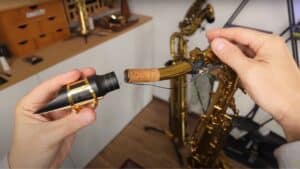
I Think I Found The New King of Saxophone Microphones

All right, this microphone goes inside the neck of your saxophone. And not only does it have an incredibly natural and even sound, but it fixes some of the biggest problems saxophonists have with standard and clip-on microphones.
I’m going to tell you all about it, how to get one, and the ways I’ve been using it. This amazing piece of technology is called the intraMic.

The IntraMic Microphone for Saxophones
It is made in Paris, France by a gentleman named Victor Egea, sorry if I’m mispronouncing your name. I know many great saxophonists who have adopted this as their microphone of choice. It was Ben Wendell that raved about it to me and so I purchased one.
I paid full price and I had to wait many months to get it. The guy who makes them knew who I was but did not ask for a review or anything. No special treatment and I have no affiliation with him or his company.
Now I know this is the sort of thing that when I make a video like this, a bunch of people will try to order one. Let me just rain on your gear acquisition parade a bit right from the beginning. As far as I’m aware, these get made by hand one at a time. As I said I had to wait several months for mine and I expect if you try to order one you too will probably have to be somewhat patient.
How the IntraMic Works
Now there does already exist pickups that get installed inside the neck of the saxophone by putting a hole in it. The intraMic is not that. This microphone does not require any modification to your horn whatsoever.
The mic goes into the neck, and the mouthpiece holds it in place like this.

Pretty genius.
Then you have this thing which is called a coupler. It allows us to connect this special short ribbon wire to a standard wire.

A wire then gets connected to a preamp which boosts the signal of the microphone. Then another wire goes from the preamp out to your mixing desk or whatever you’re plugging into.

You can request different cables at custom lengths when you order one of these microphones. By default it comes with a quarter inch jack but you can get an XLR or mini jack or whatever else you need to connect to your specific equipment.
For example I started using a Sennheiser wireless rig and asked to get a special short cable made to connect the preamp to it. Now I have a totally wireless system that works great and takes up a very small amount of space on my horn.
On the preamp you have a few cool features. First there is an on/off switch which is great for saving battery life. I do have to say that I have played many long concerts and done several recordings on the battery that it came with, that’s been in there for nearly a year and it’s still going. The battery is one of those flat round ones that goes in your key fobs.
The Best Part About the IntraMic
Then you have two switches, one is for brightness and the other is for presence, but the best part is this volume knob. I have a freaking volume knob on my saxophone now. Just that alone is worth the price. Let’s be honest, guitar players I’m looking at you, revenge is coming your way.
As the band gets louder on stage which somehow always happens whenever guitarists are present, I no longer have to wave down the sound guy and get him to ignore me while I ask for more volume, I could just turn myself up.
Sound guys don’t like to turn up sax players because they’re afraid of feedback. Well guess what? With the intraMic there is no feedback. That is one of the major problems saxophonists face, solved by this thing. You can have this thing cranked up and put your horn down right next to the monitor and nothing is going to feed back.
IntraMic Setup
The only inconvenience is the wire that has to run somewhere. The intraMic comes with some great little clips that allow you to run the wire down the F sharp or E palm key rods. This does not affect how the saxophone plays at all and keeps the wire well out of the way of your fingers.
The preamp and coupler get attached to your horn with the help of elastic bands. Now each saxophone is going to be somewhat different. On my BetterSax Classic tenor I attach the coupler right where the octave key is on the neck, still works fine, then I attach the preamp to the bell to body brace.
I run the wires down the side of the horn. I then can have a wire going out or use some sort of wireless setup. You just need to have the right cables. It does take a few minutes to set everything up and break it down, but once you get the hang of it, it all goes quickly.

How Versatile is the IntraMic?
It’s versatile enough that it can work with all types of saxophones, and I have been using this a lot on alto, tenor, and soprano. I find the sound to be very true to the natural sound of the saxophone, with the elements of the room removed so on the one hand that offers a great consistency and isolation, but on the other hand you’re losing out on that ambient room sound that you may be used to in recording situations.
For live performances I find this to be ideal since you don’t really want to be picking up all the other sounds going on around you. With this mic you’re not going to be getting bleed from the drums or other loud instruments on stage. And it’s that isolation of the sound that makes this mic perfect for sax players who want to play with pedals.
Let me know in the comments if you would be interested in a video about using effects pedals on the saxophone. There are tons of examples of this on YouTube for you to check out. Be sure to watch the video above to hear some clips that I’ve recorded to give you an idea of what I sound like on it.
How the IntraMic Solves Common Microphone Problems
One of the other problems the intraMic solves is the sound of the bell notes. With traditional mics that are typically pointed towards the bell, we end up with those lowest notes sounding really loud and out of balance with the rest of the saxophone.
With this, the entire range of the horn gets picked up very evenly. I find on straight soprano this is really helpful since that instrument is very tough to mic up and get an even sound.
Another big problem that traditional mics and especially clip-on mics have, is that they can pick up a lot of key noise. That is no longer a problem with the intraMic. You get virtually no noise in your sound with this thing, which is awesome.
My Go-To for Live Performances
I have lots of great saxophone microphones, but the intraMic has become my go-to mic for live performances. I’m still going to record mainly with my ribbon mics because I do like the sound of this acoustically treated room, but if you didn’t have a good room to record in this mic will allow you to get a very clean and consistent sound.
You can also get an isolated signal in a recording situation. So for example, you can record in the same room with other musicians and mix your saxophone sound as though you recorded it in a booth, which is a huge benefit.
I put a link to the intraMic website here. If you have any questions about it, please ask them, as they will be able to answer you much better than me.
Prices change over time, I paid around €600 for this when I got it. Your configuration might cost something else. For me, I think it’s well worth what I paid for it. I’ve been using it on and off for nearly a year now, and it’s been great.
If you have an intraMic let us know your experience with it in the comments, and if you want to know about some much less expensive sax mic options, watch this video next.
More Posts
Jay Metcalf
Leave a Comment
Your email address will not be published. Required fields are marked *
COURSES FOR
EVERY LEVEL
filter by difficulty using the tabs
- All
- Advanced
- Beginner
- Bundle
- Free
- Intermediate
- All
- Advanced
- Beginner
- Bundle
- Free
- Intermediate







One Comment
This sounds like a good idea. The downside is there’s a lot of hardware to attach to your sax. I played tenor in a ska band for a few years and put a flanger on the mic and got a real big fat sound. I mainly play flute now and have installed a Tomasi MicroCork Pickup on my flute, which replaces the head cork. It’s fantastic to be able to play as loud as the guitars. I plug into a Blackstar Sonnet 120 combo amp, which also has a DI out for the PA board.